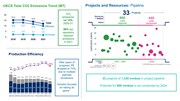
28 Apr 2022
NSTA highlights 33 new projects at industry leaders’ meeting
- Potential for 1.3 billion barrels of oil and gas in new North Sea projects
- Upstream CO2 emissions decreased by 14% in 2021
- Exploration and appraisal activity returning to pre-Covid levels
The annual performance review for the UK’s top producers highlighted 33 new projects targeting 1.3 billion barrels of oil and gas which will significantly bolster the country’s energy security.
A total of 890 million barrels of those resources could be sanctioned as early as next year and the North Sea Transition Authority (NSTA) expects operators to rapidly deliver projects, in line with its effective net zero test, in the interest of UK supply resilience.
Exploration and appraisal activity is expected to return to pre-pandemic levels, with 20 wells per year forecast from 2022-24. The appetite for exploration remains, and bodes well for NSTA plans to hold a new licensing round later this year, subject to the Climate Compatibility Checkpoint.
The NSTA also used the 28 April Tier Zero meeting to stress that an ongoing proactive approach is essential to surpass the emissions reduction targets agreed in the North Sea Transition Deal.
Held in Q2 every year, the Tier Zero gathers the managing directors of the sector’s 22 largest operators to review the performance of the basin.
Data, including from the annual UKCS Stewardship Survey, is used to show operators how they compare with peers across a series of benchmarking metrics, with a view to sharing best practice and driving improvement.
CO2 emissions for the UK upstream oil and gas industry fell 14% to 12.1 megatonnes in 2021. Furthermore, flaring across the basin fell by 19% year-on-year and venting was down by 24%. The NSTA challenged industry chiefs to sustain these lower levels in 2022, when gas production is expected to rise.
Eighty percent of Tier Zero operators have forward plans covering asset upgrades, emissions reduction and platform electrification, which will be crucial to meeting, and exceeding, Deal targets.
Indeed, the sector already has well-developed proposals for electrification projects and a number of operators are involved in government-backed industrial decarbonisation clusters focused on carbon capture and storage (CCS) and hydrogen, currently being progressed.
One of the areas highlighted in last year’s meeting was the need for a step change in well decommissioning and highly positive signs are now evident, with campaign contracting models gaining traction and the NSTA Energy Pathfinder portal listing 470 wells awaiting decommissioning.
The discussion this year also covered excellent opportunities to repurpose infrastructure for decarbonisation projects, such as CCS and H2, which are now a key area of focus. The NSTA will be launching a Carbon Storage licensing round shortly.
The NSTA urged companies to get production efficiency back on track. It slipped last year due to the large number of planned maintenance shutdowns on multiple installations, many of which were postponed the previous year due to Covid.
Following years of improvement on production efficiency, culminating in the 80% target being met in 2019, the metric dropped to 73% in 2021.
However, this indicator has long been a focus for the NSTA and industry and the managing directors confirmed their commitment to restore production efficiency to 80%.
Dr Andy Samuel, NSTA Chief Executive, said: “This meeting once again provided a good platform for positive action, supported by our suite of benchmarks and data insights. I am encouraged by the open, frank and productive dialogue. Many best practices and learnings were shared across the different operators.
“Companies are now progressing new projects that will strengthen energy security, while generating tax revenues, and creating and safeguarding thousands of UK jobs as part of an orderly transition to net zero. Importantly the industry reconfirmed commitment to halve production emissions by 2030 with progress well under way. The growing momentum on clean power to offshore installations, CCS and hydrogen was also very evident.”
Contact Information
Mark Lammey
mark.lammey@nstauthority.co.uk
Notes to editors
The North Sea Transition Deal commits industry to reduce emissions from production operations by at least 50% by 2030, against a 2018 baseline, on the path to net zero by 2050.
Production efficiency is a measurement comparing actual production to the theoretical maximum economic potential of the fields.
For more information contact:
Email: pressoffice@nstauthority.co.uk
Tel: 07776 548196

